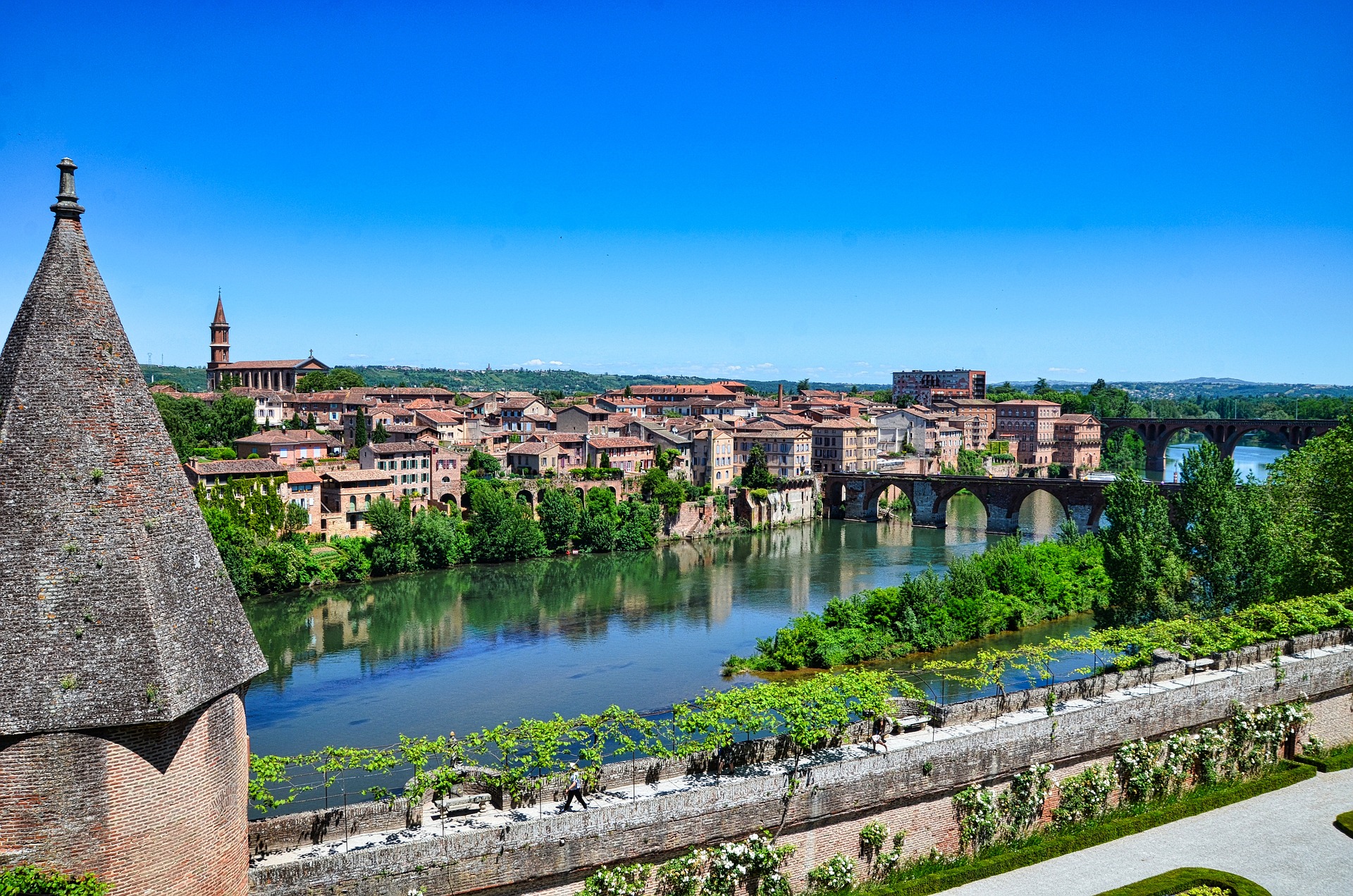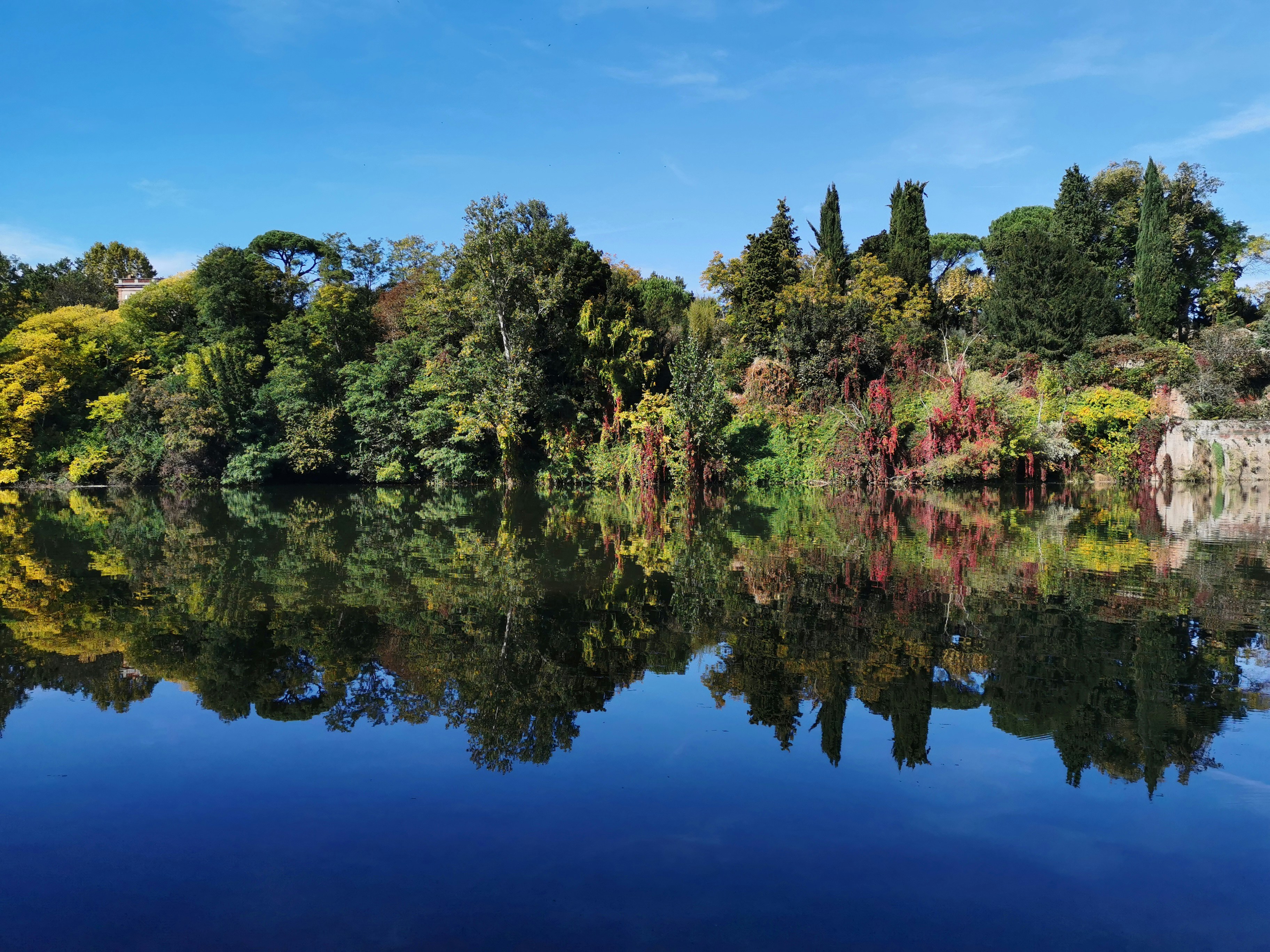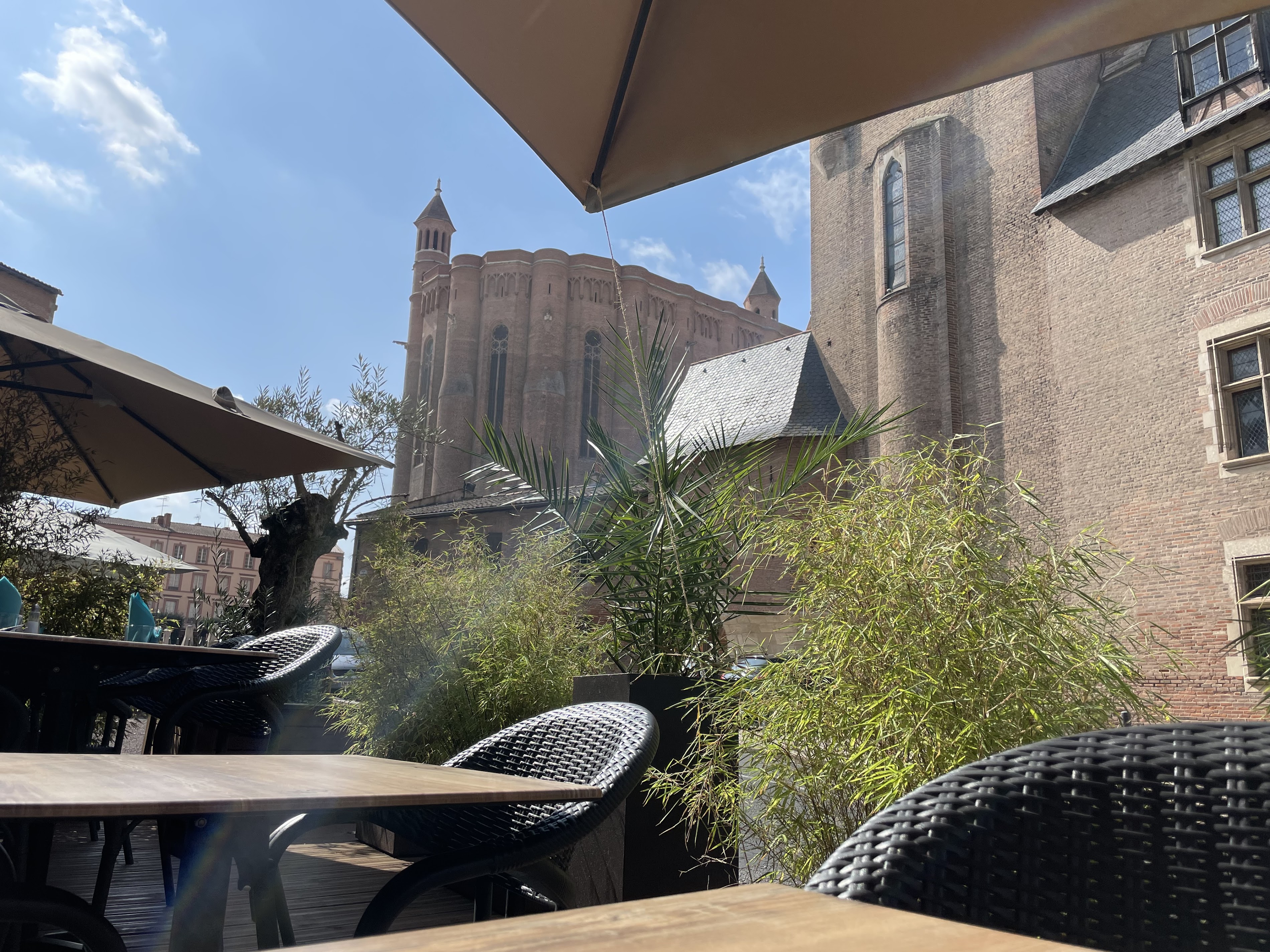Albi: Where art and history are discovered in France
In the heart of southern France, a city of red brick and golden stone awaits discovery. Ancient streets whisper tales of centuries past, while a mighty cathedral stands sentinel over the landscape. This is Albi, a place where history and art intertwine, creating a tapestry as rich and complex as the famous Toulouse-Lautrec paintings that call this city home.

A City Painted in Red
As one approaches Albi, the first impression is often one of awe. The city's distinctive red brick architecture, a legacy of its medieval past, creates a striking contrast against the azure sky. This unique urban landscape has been shaped by centuries of history, earning Albi the nickname "la ville rouge" - the red city.
The old town is characterized by its narrow, winding streets, which have been carefully preserved over the centuries. As one wanders through these ancient pathways, the weight of history can almost be felt underfoot. Half-timbered houses lean companionably towards each other, their weathered facades telling silent stories of the generations that have called them home.
Things to do in Albi
The Cathédrale Sainte-Cécile: A Fortress of Faith
At the heart of Albi stands its most iconic landmark - the Cathédrale Sainte-Cécile. This imposing structure, begun in the 13th century, is often described as the largest brick building in the world. Its exterior, with its fortress-like appearance, serves as a testament to the turbulent times in which it was built.
Yet, step inside, and one is transported to a world of breathtaking beauty. The cathedral's interior is adorned with intricate frescoes, their vibrant colors seemingly undimmed by the passage of time. The Last Judgment fresco, which covers the entire western wall, is particularly awe-inspiring. It's a masterpiece that demands contemplation, inviting visitors to lose themselves in its intricate details and powerful imagery.
A Tribute to Toulouse-Lautrec
Albi's cultural significance extends beyond its architectural marvels. The city is proud to be the birthplace of Henri de Toulouse-Lautrec, the Post-Impressionist painter known for his vivid depictions of Parisian nightlife. The Musée Toulouse-Lautrec, housed in the Palais de la Berbie, is a must-visit for art enthusiasts.
Within the museum's walls, over a thousand of Toulouse-Lautrec's works are displayed. From his early sketches to his iconic posters of the Moulin Rouge, the collection offers a comprehensive look at the artist's life and career. The museum itself, with its elegant gardens overlooking the Tarn River, provides a fitting backdrop for these masterpieces.
A Culinary Journey
Albi's gastronomic scene is as rich and varied as its history. Local specialties are celebrated in the city's restaurants and markets. The famous pink garlic of Lautrec, grown in nearby fields, features prominently in many dishes. At the covered market, the aromas of freshly baked bread, local cheeses, and seasonal produce create a sensory experience that's not to be missed.
Wine enthusiasts will find much to appreciate in Albi. The city serves as a gateway to the Gaillac wine region, one of the oldest in France. These wines, with their unique character shaped by the local terroir, perfectly complement the hearty cuisine of the Southwest.
A Living Heritage
Despite its ancient roots, Albi is far from a city trapped in the past. Modern life pulses through its historic streets, with boutiques, cafes, and galleries adding contemporary flair to the medieval backdrop. The Pont Vieux, a thousand-year-old bridge that spans the Tarn, serves as a poignant symbol of Albi's ability to bridge the gap between past and present.

Albi's commitment to preserving its heritage while embracing the future was recognized in 2010 when the episcopal city was designated a UNESCO World Heritage site. This honor not only celebrates Albi's historical significance but also ensures that future generations will be able to experience its unique charm.
As the sun sets over Albi, painting the red brick in hues of gold and rose, one can't help but feel a sense of timelessness. This is a city that has witnessed centuries of history, yet remains vibrantly alive. Whether you're drawn by its art, architecture, cuisine, or simply its ineffable charm, Albi offers a truly unforgettable experience. For those seeking to explore more of France's rich cultural tapestry, a trip to Toulouse, known as the "Pink City," could be an excellent complement to your visit to Albi, offering another perspective on the region's unique architectural heritage.
When to visit Albi
January
February
March
April
May
June
July
August
September
October
November
December
Top attractions in Albi
Show all
Musée Toulouse-Lautrec
Nestled in the historic city of Albi, France, the Musée Toulouse-Lautrec is a must-visit destination for art lovers and history enthusiasts alike. Dedicated to the life and work of the renowned Post-Impressionist painter Henri de Toulouse-Lautrec, this museum offers a captivating glimpse into the artist's vibrant and often provocative oeuvre.
Albi - FRANCE

Berbie Palace
Nestled along the banks of the Tarn River in the historic city of Albi, France, the Berbie Palace stands as a testament to the region's rich cultural heritage. Once the residence of the powerful Archbishops of Albi, this magnificent medieval structure has been carefully preserved, offering visitors a glimpse into the past and a glimpse into the architectural wonders that grace Albi's landscape.
Albi - FRANCE

Musée Lapérouse
Nestled in the heart of Albi, a UNESCO World Heritage Site, stands the Musée Lapérouse, a captivating museum that celebrates the life and legacy of one of France's most renowned explorers. This museum is a testament to the city's rich history and its deep connection to the age of discovery.
Albi - FRANCE

Sainte-Cecile Cathedral of Albi
In the heart of Albi, a striking sight captures the attention of every visitor: the magnificent Sainte-Cécile Cathedral. This architectural marvel, known for its impressive brick façade and towering presence, offers an invitation to explore a rich tapestry of history and artistry. The vibrant streets surrounding the cathedral are filled with shops, cafes, and the warm buzz of conversation, drawing people in with their charm.
Albi - FRANCE

Jardin National
In the heart of Albi, a vibrant atmosphere fills the air as visitors and locals alike enjoy the beauty of the Jardin National. This park serves as a peaceful retreat from the bustling streets, where families gather for picnics and friends share laughter under the shade of trees. The park offers a perfect blend of natural beauty and cultural charm, making it a must-visit destination for anyone exploring the city.
Albi - FRANCE

Parc Rochegude
The vibrant atmosphere of Albi welcomes visitors with its rich history and stunning architecture. Among the many attractions, a peaceful retreat known for its scenic beauty and recreational opportunities can be found. This destination offers a perfect blend of nature and leisure, inviting everyone to unwind and enjoy the surroundings.
Albi - FRANCE
Michelin Restaurants in Albi
Show all
Amapola Kitchen
The superlative location, at the foot of Pont Vieux overlooking the historic town and its stunning cathedral, is definitely Instagram worthy. This cleverly revamped pocket handkerchief bistro is in the hands of a former art historian, whose healthy, colourful, well-crafted dishes to be shared hit the spot every time. This unorthodox, fine food DJ mixes South American, Italian and Comorian influences, with a generous scattering of lacto fermented ingredients and a definite preference for organic sources, such as the Comorian-style minced beef flanked by red onion and chervil pickles and the delicious house houmous. Fine selection of organic and natural wines.
Albi - FRANCE

Alchimy
In the heart of the old town, this handsome Art Deco building is home to a contemporary-style brasserie with an attractive glazed roof and an imposing Murano chandelier – a pleasant setting in which to peruse a menu packed with enticing options. Using local produce, the chef puts his own spin on the classics: seared salmon gravlax served with a mushroom salad; a fine cut of Tarn pork; a new version of tarte Tatin with Granny Smith opaline. Pure alchemy!
Albi - FRANCE

La Table du Sommelier
A father-and-son team of trained sommeliers work in tandem in this pleasant contemporary bistro. The result is flavoursome, indulgent wine-based dishes that put a skilful new spin on the offerings of the local terroir, such as the fillet of blue ling with parsley, wild rice and sesame oil, or the raspberry and vanilla in sablé and mousse forms. The cellar boasts almost 500 wines, and in summer there are two terraces to choose from: beneath the pergola or in the open air. Highly recommended and excellent value for money.
Albi - FRANCE

L'Épicurien
Luck has nothing to do with the current reputation of this downtown venue, facing Jean Jaurès Fountain, as the darling of the town’s discerning epicureans. The stripped-back interior sports a distinctly Scandinavian feel, which given the chef’s Swedish origins is hardly a surprise. On the culinary front, he deploys his undisputed talent, adding a new twist to French classics and conjuring up enticing recipes in tune with the era: generous portions, well crafted and oozing with flavour. The intelligent wine list and crack table staff, as professional as they are friendly, add the final flourish.
Albi - FRANCE
Best Restaurants in Albi
Show all
Bruno Restaurant
Dine in • Lunch • Dinner • Vegetarian Friendly • Wheelchair-accessible entrance
Albi - FRANCE

Restaurant Le Quai Choiseul
Dine in • Breakfast • Lunch • Dinner • Wheelchair-accessible entrance
Albi - FRANCE

La Forge du Vieil Alby
Dine in • Takeaway • Breakfast • Lunch • Dinner • Vegetarian Friendly • Wheelchair-accessible entrance
Albi - FRANCE

La Copa, restaurant Bar Tapas
Dine in • Takeaway • Lunch • Dinner • Wheelchair-accessible entrance
Albi - FRANCE

MEUH ! Restaurant Albi Le Séquestre
Dine in • Takeaway • Delivery • Lunch • Dinner • Wheelchair-accessible entrance
Albi - FRANCE
Related articles
Show all
The 15 best things to do in Orléans
France's heartland beckons with a tapestry of history, culture, and natural beauty. Nestled along the banks of the Loire River, a city steeped in medieval lore and Renaissance grandeur awaits discovery. From Joan of Arc's legacy to vibrant markets and lush gardens, this gem of the Loire Valley offers a captivating blend of past and present. Let's embark on a journey through the top 15 experiences that shouldn't be missed in this enchanting destination.
Orléans - FRANCE

The 15 best things to do in Giverny
In the heart of Normandy, a small village has been immortalized through the brushstrokes of one of history's most celebrated artists. This enchanting locale, where art and nature intertwine, beckons visitors to step into a living canvas. Here, the spirit of Impressionism can be felt in every blooming flower and shimmering reflection on tranquil waters. For those seeking to immerse themselves in beauty both natural and man-made, a journey to this artistic haven promises unforgettable experiences.
Les Andelys - FRANCE

The top 15 things to do in Le Havre
France's northern coast has long been admired for its rugged beauty and rich maritime heritage. Among the jewels of this region, one city stands out for its unique blend of history, culture, and modern architecture. Founded in 1517 by King Francis I, this port town has been shaped by centuries of maritime trade, wartime destruction, and bold reconstruction. Today, it offers visitors a fascinating glimpse into both France's past and its vision for the future.
Le Havre - FRANCE

Top 15 things to do in Le Puy-en-Velay
Nestled in the heart of France's Auvergne region, a city of extraordinary beauty and historical significance awaits discovery. Medieval architecture, volcanic landscapes, and spiritual heritage converge in this enchanting destination, offering visitors a unique blend of cultural experiences and natural wonders. From ancient pilgrimage routes to gastronomic delights, this captivating city promises an unforgettable journey through time and tradition.
Le Puy-en-Velay - FRANCE

Best 15 things to do in Chambéry
Nestled in the heart of the French Alps, a charming city awaits discovery. With its rich history, stunning architecture, and proximity to natural wonders, this hidden gem offers a perfect blend of culture and outdoor adventure. From medieval castles to mountain hikes, a wealth of experiences can be found in this captivating destination. Let's explore the top 15 activities that shouldn't be missed during a visit to this alpine treasure.
Chambéry - FRANCE

The 15 best things to do in Brest
Tucked away on the rugged coast of Brittany, a city of maritime heritage and modern allure awaits discovery. With its storied past and vibrant present, this French gem offers a unique blend of cultural experiences, natural wonders, and nautical adventures. From historic landmarks to cutting-edge attractions, visitors will find themselves immersed in a world where tradition and innovation coexist harmoniously.
Brest - FRANCE




 Home
Home Wishlist
Wishlist